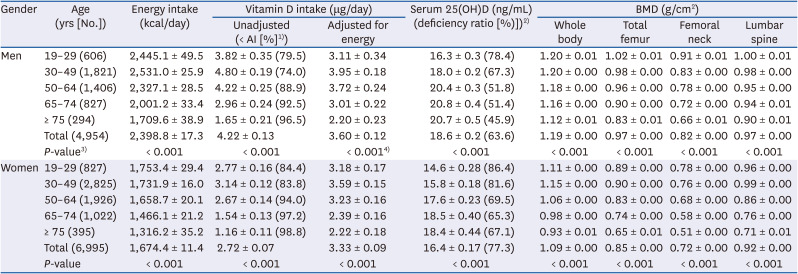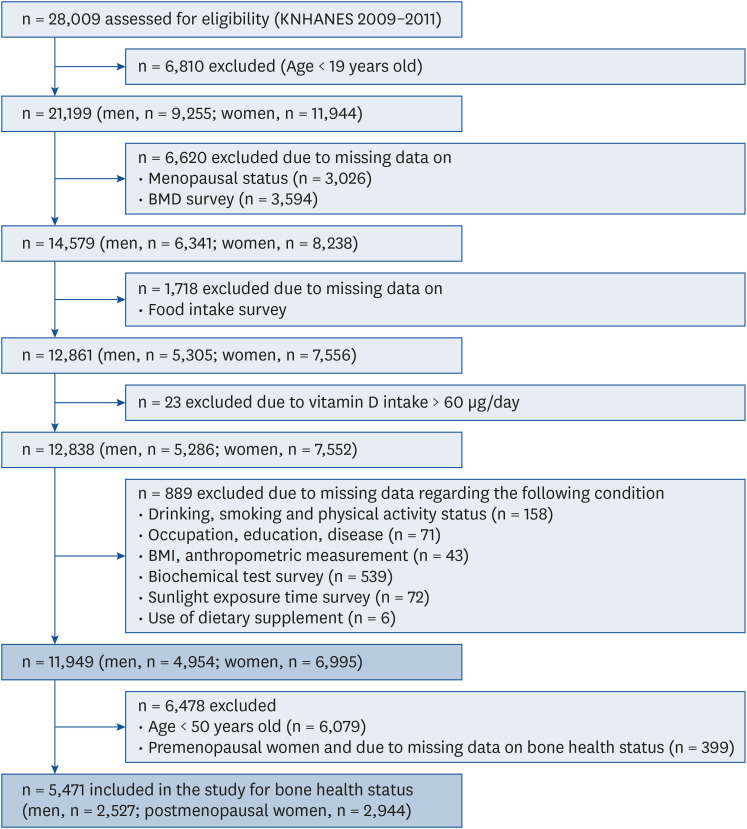1. Lips P, van Schoor NM. The effect of vitamin D on bone and osteoporosis. Best Pract Res Clin Endocrinol Metab. 2011; 25:585–591. PMID:
21872800.

2. Shin HA, Om AS. The correlation between dietary intakes of calcium and vitamin D and osteoporosis, hypertension and diabetes mellitus. J Milk Sci Biotechnol. 2009; 27:17–23.
3. Cândido FG, Bressan J. Vitamin D: link between osteoporosis, obesity, and diabetes? Int J Mol Sci. 2014; 15:6569–6591. PMID:
24747593.

4. Maki KC, Rubin MR, Wong LG, McManus JF, Jensen CD, Marshall JW, Lawless A. Serum 25-hydroxyvitamin D is independently associated with high-density lipoprotein cholesterol and the metabolic syndrome in men and women. J Clin Lipidol. 2009; 3:289–296. PMID:
21291826.

5. Merlino LA, Curtis J, Mikuls TR, Cerhan JR, Criswell LA, Saag KG. Vitamin D intake is inversely associated with rheumatoid arthritis: results from the Iowa Women's Health Study. Arthritis Rheum. 2004; 50:72–77. PMID:
14730601.

6. Cantorna MT, Zhu Y, Froicu M, Wittke A. Vitamin D status, 1,25-dihydroxyvitamin D3, and the immune system. Am J Clin Nutr. 2004; 80:1717S–1720S. PMID:
15585793.

7. Freedman DM, Dosemeci M, McGlynn K. Sunlight and mortality from breast, ovarian, colon, prostate, and non-melanoma skin cancer: a composite death certificate based case-control study. Occup Environ Med. 2002; 59:257–262. PMID:
11934953.

8. Holick MF. The vitamin D deficiency pandemic: approaches for diagnosis, treatment and prevention. Rev Endocr Metab Disord. 2017; 18:153–165. PMID:
28516265.

9. Prentice A, Goldberg GR, Schoenmakers I. Vitamin D across the lifecycle: physiology and biomarkers. Am J Clin Nutr. 2008; 88:500S–506S. PMID:
18689390.

10. Hanley DA, Cranney A, Jones G, Whiting SJ, Leslie WD, Cole DE, Atkinson SA, Josse RG, Feldman S, Kline GA, et al. Vitamin D in adult health and disease: a review and guideline statement from Osteoporosis Canada. CMAJ. 2010; 182:E610–E618. PMID:
20624868.

11. Del Valle HB, Yaktine AL, Taylor CL, Ross AC. Institute of Medicine (US) Committee to Review Dietary Reference Intakes for Vitamin D and Calcium. Dietary Reference Intakes for Calcium and Vitamin D. Washington, D.C.: National Academies Press;2011.
12. World Health Organization. Prevention and Management of Osteoporosis: Report of a WHO Scientific Group. Geneva: World Health Organization;2003.
13. Yoo K, Cho J, Ly S. Vitamin D intake and serum 25-hydroxyvitamin D levels in Korean adults: analysis of the 2009 Korea National Health and Nutrition Examination Survey (KNHANES IV-3) using a newly established vitamin D database. Nutrients. 2016; 8:610. PMID:
27690097.

14. Lee MK, Yoon BK, Chung HY, Park HM. The serum vitamin D nutritional status and its relationship with skeletal status in Korean postmenopausal women. Korean J Obstet Gynecol. 2011; 54:241–246.

15. Park EJ, Joo IW, Jang MJ, Kim YT, Oh K, Oh HJ. Prevalence of osteoporosis in the Korean population based on Korea National Health and Nutrition Examination Survey (KNHANES), 2008–2011. Yonsei Med J. 2014; 55:1049–1057. PMID:
24954336.

16. Ha YC. Epidemiology of osteoporosis in Korea. J Korean Med Assoc. 2016; 59:836–841.

17. Lee EJ, Son SM. Dietary risk factors related to bone mineral density in the postmenopausal women with low bone mineral density. Korean J Community Nutr. 2004; 9:644–653.
18. Hwang YC, Ahn HY, Jeong IK, Ahn KJ, Chung HY. Optimal serum concentration of 25-hydroxyvitamin D for bone health in older Korean adults. Calcif Tissue Int. 2013; 92:68–74. PMID:
23179104.

19. Delvin EE, Imbach A, Copti M. Vitamin D nutritional status and related biochemical indices in an autonomous elderly population. Am J Clin Nutr. 1988; 48:373–378. PMID:
3407617.

20. Villareal DT, Civitelli R, Chines A, Avioli LV. Subclinical vitamin D deficiency in postmenopausal women with low vertebral bone mass. J Clin Endocrinol Metab. 1991; 72:628–634. PMID:
1997517.

21. Kim MY, Kim MJ, Ly SY. Vitamin D intake, serum 25OHD, and bone mineral density of Korean adults: based on the Korea National Health and Nutrition Examination Survey (KNHANES, 2011). J Nutr Health. 2016; 49:437–446.

22. Ohta H, Kuroda T, Tsugawa N, Onoe Y, Okano T, Shiraki M. Optimal vitamin D intake for preventing serum 25-hydroxyvitamin D insufficiency in young Japanese women. J Bone Miner Metab. 2018; 36:620–625. PMID:
29124437.

23. Kim H, Beom SH, Lee SH, Koh JM, Kim BJ, Kim TH. Differential association of dietary fat intake with DXA-based estimates of bone strength according to sex in the KNHANES IV population. Arch Osteoporos. 2020; 15:62. PMID:
32333189.

24. Yoo KO, Kim MJ, Ly SY. Association between vitamin D intake and bone mineral density in Koreans aged ≥ 50 years: analysis of the 2009 Korea National Health and Nutrition Examination Survey using a newly established vitamin D database. Nutr Res Pract. 2019; 13:115–125. PMID:
30984355.

25. Jung SJ, Hwangbo Y, Jung JH, Kim J, Kim H, Jeong KH, Lee DW, Cho SH, Kim HW. Recent trends in serum vitamin D levels among Korean population: Korea National Health and Nutrition Examination Survey 2008–2014. Korean J Clin Geri. 2018; 19:55–62.

26. Yoon JS, Song MK. Vitamin D intake, outdoor activity time and serum 25-OH vitamin D concentrations of Korean postmenopausal women by season and by age. Korean J Community Nutr. 2015; 20:120–128.

27. Freisling H, Fahey MT, Moskal A, Ocké MC, Ferrari P, Jenab M, Norat T, Naska A, Welch AA, Navarro C, et al. Region-specific nutrient intake patterns exhibit a geographical gradient within and between European countries. J Nutr. 2010; 140:1280–1286. PMID:
20484545.

28. Harnack LJ, Steffen L, Zhou X, Luepker RV. Trends in vitamin D intake from food sources among adults in the Minneapolis-St Paul, MN, metropolitan area, 1980–1982 through 2007–2009. J Am Diet Assoc. 2011; 111:1329–1334. PMID:
21872696.

29. Lamberg-Allardt C, Brustad M, Meyer HE, Steingrimsdottir L. Vitamin D - a systematic literature review for the 5th edition of the Nordic Nutrition Recommendations. Food Nutr Res. 2013; 57:22671.

30. Madsen KH, Rasmussen LB, Andersen R, Mølgaard C, Jakobsen J, Bjerrum PJ, Andersen EW, Mejborn H, Tetens I. Randomized controlled trial of the effects of vitamin D–fortified milk and bread on serum 25-hydroxyvitamin D concentrations in families in Denmark during winter: the VitmaD study. Am J Clin Nutr. 2013; 98:374–382. PMID:
23783292.

31. Grønborg IM, Tetens I, Christensen T, Andersen EW, Jakobsen J, Kiely M, Cashman KD, Andersen R. Vitamin D-fortified foods improve wintertime vitamin D status in women of Danish and Pakistani origin living in Denmark: a randomized controlled trial. Eur J Nutr. 2020; 59:741–753. PMID:
30852657.

32. Cashman KD, Fitzgerald AP, Kiely M, Seamans KM. A systematic review and meta-regression analysis of the vitamin D intake-serum 25-hydroxyvitamin D relationship to inform European recommendations. Br J Nutr. 2011; 106:1638–1648. PMID:
22000709.

33. Kiely M, Cashman KD. Summary outcomes of the ODIN project on food fortification for vitamin D deficiency prevention. Int J Environ Res Public Health. 2018; 15:2342. PMID:
30352957.

34. Cashman KD, Kiely M. Vitamin D and food fortification. Feldman D, editor. Vitamin D. Cambridge (MA): Academic Press;2018. p. 109–127.
35. Asakura K, Etoh N, Imamura H, Michikawa T, Nakamura T, Takeda Y, Mori S, Nishiwaki Y. Vitamin D status in Japanese adults: Relationship of serum 25-hydroxyvitamin D with simultaneously measured dietary vitamin D intake and ultraviolet ray exposure. Nutrients. 2020; 12:743. PMID:
32168939.

36. Langlois K, Greene-Finestone L, Little J, Hidiroglou N, Whiting S. Vitamin D status of Canadians as measured in the 2007 to 2009 Canadian Health Measures Survey. Health Rep. 2010; 21:47–55.
37. Chailurkit LO, Aekplakorn W, Ongphiphadhanakul B. Regional variation and determinants of vitamin D status in sunshine-abundant Thailand. BMC Public Health. 2011; 11:853. PMID:
22074319.

38. Gropper SS, Smith JL. Advanced Nutrition and Human Metabolism. Boston (MA): Cengage Learning;2012.
39. Nieves JW. Osteoporosis: the role of micronutrients. Am J Clin Nutr. 2005; 81:1232S–1239S. PMID:
15883457.

40. Spiro A, Buttriss JL, Vitamin D. Vitamin D: an overview of vitamin D status and intake in Europe. Nutr Bull. 2014; 39:322–350. PMID:
25635171.
41. Laaksi IT, Ruohola JP, Ylikomi TJ, Auvinen A, Haataja RI, Pihlajamäki HK, Tuohimaa PJ. Vitamin D fortification as public health policy: significant improvement in vitamin D status in young Finnish men. Eur J Clin Nutr. 2006; 60:1035–1038. PMID:
16482069.

42. Bischoff-Ferrari HA, Willett WC, Wong JB, Stuck AE, Staehelin HB, Orav EJ, Thoma A, Kiel DP, Henschkowski J. Prevention of nonvertebral fractures with oral vitamin D and dose dependency: a meta-analysis of randomized controlled trials. Arch Intern Med. 2009; 169:551–561. PMID:
19307517.

43. Ebeling PR, Eisman JA. Vitamin D and osteoporosis. Feldman D, editor. Vitamin D. Cambridge (MA): Academic Press;2018. p. 203–220.
44. Feskanich D, Willett WC, Colditz GA. Calcium, vitamin D, milk consumption, and hip fractures: a prospective study among postmenopausal women. Am J Clin Nutr. 2003; 77:504–511. PMID:
12540414.

45. Polzonetti V, Pucciarelli S, Vincenzetti S, Polidori P. Dietary intake of vitamin d from dairy products reduces the risk of osteoporosis. Nutrients. 2020; 12:1743. PMID:
32532150.

46. Ho-Pham LT, Nguyen ND, Nguyen TV. Effect of vegetarian diets on bone mineral density: a Bayesian meta-analysis. Am J Clin Nutr. 2009; 90:943–950. PMID:
19571226.

47. Reid IR, Horne AM, Mihov B, Gamble GD, Al-Abuwsi F, Singh M, Taylor L, Fenwick S, Camargo CA, Stewart AW, et al. Effect of monthly high-dose vitamin D on bone density in community-dwelling older adults substudy of a randomized controlled trial. J Intern Med. 2017; 282:452–460. PMID:
28692172.

48. Joo NS, Dawson-Hughes B, Kim YS, Oh K, Yeum KJ. Impact of calcium and vitamin D insufficiencies on serum parathyroid hormone and bone mineral density: analysis of the fourth and fifth Korea National Health and Nutrition Examination Survey (KNHANES IV-3, 2009 and KNHANES V-1, 2010). J Bone Miner Res. 2013; 28:764–770. PMID:
23045165.

49. Kuiper JW, van Kuijk C, Grashuis JL, Ederveen AG, Schütte HE. Accuracy and the influence of marrow fat on quantitative CT and dual-energy X-ray absorptiometry measurements of the femoral neck in vitro. Osteoporos Int. 1996; 6:25–30. PMID:
8845596.

50. Blake GM, Griffith JF, Yeung DKW, Leung PC, Fogelman I. Effect of increasing vertebral marrow fat content on BMD measurement, T-score status and fracture risk prediction by DXA. Bone. 2009; 44:495–501. PMID:
19059505.

51. Griffith JF, Yeung DK, Antonio GE, Wong SY, Kwok TC, Woo J, Leung PC. Vertebral marrow fat content and diffusion and perfusion indexes in women with varying bone density: MR evaluation. Radiology. 2006; 241:831–838. PMID:
17053202.










 PDF
PDF Citation
Citation Print
Print




 XML Download
XML Download